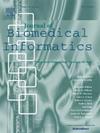定义初级保健电子健康记录中长期心血管、肾脏、代谢和精神健康状况的疾病严重程度的表型:一项使用名义组技术的混合方法研究
IF 4.5
2区 医学
Q2 COMPUTER SCIENCE, INTERDISCIPLINARY APPLICATIONS
引用次数: 0
摘要
目的纳入长期疾病的严重程度措施可以改善多种长期疾病的预测模型,但某些严重程度措施在电子健康记录(EHR)中的可用性有限。我们的目的是就九种心肾代谢和精神健康状况的可行严重表型达成共识。方法采用新方法进行混合方法研究。从现有文献中,我们确定了潜在的严重表型,并通过分析临床实践研究数据链(CPRD) Aurum数据库(一个大型英国初级保健电子病历数据库)中随机选择的31个全科病例的数据,探讨了它们在电子病历中应用的可行性。我们招募临床学术专家参加调查和名义上的小组技术研讨会。参与者使用李克特量表独立评估每种严重表型的临床重要性和可行性(由探索性分析告知)。对于每种疾病的最佳严重表型(最高综合评分),使用全CPRD数据库的Cox回归计算5年死亡率的调整风险比(aHR)。结果对9种情况的15个现有严重程度指标进行了调查。18位临床学者参加了调查,12位也参加了研讨会。慢性肾脏疾病(CKD)肾小球滤过率(eGFR)的临床重要性和可行性综合平均得分最高(9.42/10),糖尿病微血管并发症(9.08/10)。eGFR分期每减少一次,死亡率就会增加;与3a期CKD相比,3b期aHR为1.42,95% CI为1.41-1.44,每增加一个糖尿病微血管并发症;1例并发症aHR 1.44, 95% CI 1.32-1.57,无并发症。一些表型(例如,动脉瘤直径)在数据库中没有很好地记录,因此无法应用。结论:我们开发了一种识别电子病历严重程度表型的方法。糖尿病(1型和2型)、缺血性心脏病、CKD和周围血管疾病的严重表型被确定。对于记录不足的严重程度措施,应改进电子病历中的数据质量。本文章由计算机程序翻译,如有差异,请以英文原文为准。

Defining phenotypes of disease severity for long-term cardiovascular, renal, metabolic, and mental health conditions in primary care electronic health records: A mixed-methods study using the nominal group technique
Objective
Inclusion of severity measures for long-term conditions (LTC) could improve prediction models for multiple long-term conditions (MLTC) but some severity measures have limited availability in electronic health records (EHR). We aimed to develop consensus on feasible severity phenotypes for nine cardio-renal-metabolic and mental health conditions.
Methods
This was a mixed-methods study using novel methodology. From existing literature, we identified potential severity phenotypes and explored feasibility of their use in EHR through analysis of data from 31 randomly selected general practices in the Clinical Practice Research Datalink (CPRD) Aurum database, a large UK-based primary care EHR database. We recruited clinical academic experts to participate in a survey and nominal group technique workshop. Participants used a Likert scale to rate clinical importance and feasibility for each severity phenotype independently (informed by the exploratory analysis). For the optimal severity phenotype (highest combined score) for each condition, adjusted hazard ratios (aHR) of five-year mortality were calculated using Cox regression on the full CPRD database.
Results
Fifteen existing severity indexes for nine conditions informed the survey. Eighteen clinical academics participated in the survey, twelve also participated in the workshops. Combined mean scores for clinical importance and feasibility were highest for estimated glomerular filtration rate (eGFR) for chronic kidney disease (CKD) (9.42/10) and for microvascular complications of diabetes (9.08/10). Mortality was higher for each reduction in eGFR stage; Stage 3b aHR 1.42, 95 %CI 1.41–1.44 versus Stage 3a CKD and for each additional microvascular complication of diabetes; one complication aHR 1.44, 95 %CI 1.32–1.57 versus none. Some phenotypes (e.g., aneurysm diameter) were not well recorded within the database and could not feasibly be applied.
Conclusion
We developed a methodology for identifying severity phenotypes in EHRs. Severity phenotypes were identified for diabetes (type 1 and 2), ischaemic heart disease, CKD and peripheral vascular disease. Data quality in EHR should be improved for under-recorded severity measures.
求助全文
通过发布文献求助,成功后即可免费获取论文全文。
去求助
来源期刊

Journal of Biomedical Informatics
医学-计算机:跨学科应用
CiteScore
8.90
自引率
6.70%
发文量
243
审稿时长
32 days
期刊介绍:
The Journal of Biomedical Informatics reflects a commitment to high-quality original research papers, reviews, and commentaries in the area of biomedical informatics methodology. Although we publish articles motivated by applications in the biomedical sciences (for example, clinical medicine, health care, population health, and translational bioinformatics), the journal emphasizes reports of new methodologies and techniques that have general applicability and that form the basis for the evolving science of biomedical informatics. Articles on medical devices; evaluations of implemented systems (including clinical trials of information technologies); or papers that provide insight into a biological process, a specific disease, or treatment options would generally be more suitable for publication in other venues. Papers on applications of signal processing and image analysis are often more suitable for biomedical engineering journals or other informatics journals, although we do publish papers that emphasize the information management and knowledge representation/modeling issues that arise in the storage and use of biological signals and images. System descriptions are welcome if they illustrate and substantiate the underlying methodology that is the principal focus of the report and an effort is made to address the generalizability and/or range of application of that methodology. Note also that, given the international nature of JBI, papers that deal with specific languages other than English, or with country-specific health systems or approaches, are acceptable for JBI only if they offer generalizable lessons that are relevant to the broad JBI readership, regardless of their country, language, culture, or health system.
 求助内容:
求助内容: 应助结果提醒方式:
应助结果提醒方式:


